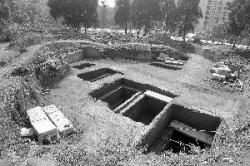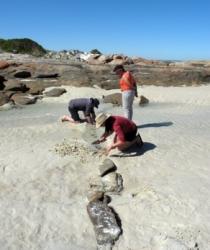INSTITUT SUPERIEUR D'ANTHROPOLOGIE
INSTITUTE OF ANTHROPOLOGY
ONLINE COURSES / COURS A DISTANCE
NEW OPEN COURSE : JANUARY 2013
HRM 104 : INTRODUCTION TO INTANGIBLE CULTURAL HERITAGE
REGISTER NOW
CHINE –  Nanjing - Archaeologists have found 46 ancient tombs in Nanjing Forestry University of Jiangsu province. The tombs, dating back to around AD 229, are considered to be very important archaeological discoveries. More than 100 funerary objects, including gold plates, silverware, pottery and porcelain, have been found in the tombs that are located on a hill at the university. All the tombs were buried with single person inside, and no spouses have yet been found, according to a man surnamed Xu, who is in charge of the archaeological work. Of all the ancient tombs found, only six have never been robbed, Xu said. Last year another tomb whose owner was said to be an offspring of Xu Da, a famous general of the Ming Dynasty (1368-1662), was also found at the university.
Nanjing - Archaeologists have found 46 ancient tombs in Nanjing Forestry University of Jiangsu province. The tombs, dating back to around AD 229, are considered to be very important archaeological discoveries. More than 100 funerary objects, including gold plates, silverware, pottery and porcelain, have been found in the tombs that are located on a hill at the university. All the tombs were buried with single person inside, and no spouses have yet been found, according to a man surnamed Xu, who is in charge of the archaeological work. Of all the ancient tombs found, only six have never been robbed, Xu said. Last year another tomb whose owner was said to be an offspring of Xu Da, a famous general of the Ming Dynasty (1368-1662), was also found at the university.
http://www.kaogu.cn/en/detail.asp?ProductID=3718
ITALIE –  Val di Non - Archaeologists in Trento announced Wednesday that an ancient Celtic artifact found some 60 years ago in this alpine region is, in fact, a Celtic war horn. The horn was found in the Val di Non valley, an area more known for apples than for ancient artifacts. While it was understood to be of Celtic origin, the use of the instrument - made of what appeared to be tubes and a bronze “leaf” - remained a mystery. However, recently, archaeologists in Tintignac, France, uncovered a similar relic whose much better state allowed them to understand that it was, in fact, a horn. According to archaeologists, the horns, called karnykes, were part of a psychological warfare technique: when accompanied by the cries of attacking Celtic warriors and the rumbling sounds of their war carts, they helped instill a sense of fear and doom in their adversaries. Other similar instruments have been found in France, Switzerland, Germany and Romania.
Val di Non - Archaeologists in Trento announced Wednesday that an ancient Celtic artifact found some 60 years ago in this alpine region is, in fact, a Celtic war horn. The horn was found in the Val di Non valley, an area more known for apples than for ancient artifacts. While it was understood to be of Celtic origin, the use of the instrument - made of what appeared to be tubes and a bronze “leaf” - remained a mystery. However, recently, archaeologists in Tintignac, France, uncovered a similar relic whose much better state allowed them to understand that it was, in fact, a horn. According to archaeologists, the horns, called karnykes, were part of a psychological warfare technique: when accompanied by the cries of attacking Celtic warriors and the rumbling sounds of their war carts, they helped instill a sense of fear and doom in their adversaries. Other similar instruments have been found in France, Switzerland, Germany and Romania.
http://www.ansa.it/web/notizie/rubriche/english/2012/11/14/Archaeologists-say-Celtic-relic-found-Alps-war-horn_7795803.html
TURQUIE –  Milas - A cistern has been found during the archaeological excavation of King Hecatomnus' grave in Milas district of Muğla province in southwestern Turkey. The vaulted and rectangular-shaped cistern is located 100 meters from Hecatomnus' grave. "We suppose that it might be only one part of a complex of cisterns" the director of the Milas Museum, Ali Sinan Özbey, said, adding that this region will be opened for visitors as an archaeo-park when the excavation of the 2,400-year-old remains of Hecatomnus is finished.
Milas - A cistern has been found during the archaeological excavation of King Hecatomnus' grave in Milas district of Muğla province in southwestern Turkey. The vaulted and rectangular-shaped cistern is located 100 meters from Hecatomnus' grave. "We suppose that it might be only one part of a complex of cisterns" the director of the Milas Museum, Ali Sinan Özbey, said, adding that this region will be opened for visitors as an archaeo-park when the excavation of the 2,400-year-old remains of Hecatomnus is finished.
http://www.hurriyetdailynews.com/cistern-found-in-milas.aspx?pageID=238&nID=34720&NewsCatID=375
GRECE –  Pirée - A significant part of the Cononian walls of Piraeus, which measured approximately 450 m in length, will be restored, aiming at the promotion of the remains of Antiquity at the Athenian port. The restoration will be based on a new study, which has been approved by the Central Archaeological Council. The part which will be restored is located at the Themistocles coast, in front of the Cruise Passenger Terminal B of the Piraeus Port Authority, and beside the new conference and exhibition centre of the port. The Cononian walls were built in 394 BC, by Conon, an Athenian general at the end of the Peloponnesian War, and are preserved at 2,5 km length. The part to be restored has been unearthed during landscaping works conducted in Piraeus for the Olympic Games 2004.
Pirée - A significant part of the Cononian walls of Piraeus, which measured approximately 450 m in length, will be restored, aiming at the promotion of the remains of Antiquity at the Athenian port. The restoration will be based on a new study, which has been approved by the Central Archaeological Council. The part which will be restored is located at the Themistocles coast, in front of the Cruise Passenger Terminal B of the Piraeus Port Authority, and beside the new conference and exhibition centre of the port. The Cononian walls were built in 394 BC, by Conon, an Athenian general at the end of the Peloponnesian War, and are preserved at 2,5 km length. The part to be restored has been unearthed during landscaping works conducted in Piraeus for the Olympic Games 2004.
http://www.archaiologia.gr/en/
FRANCE - Asnières-sur-Nouère - C’est une belle découverte archéologique qui est en train de voir le jour du côté d’Asnières-sur-Nouère. Dans le cadre des travaux de la LGV, les vestiges d’un village médiéval oublié semblent être en passe d’être exhumés sur une parcelle d’environ 5 hectares. «Pour l’instant, rien n’est visible. Mais nous avons de très fortes présomptions sur la découverte d’un tel village, avec tout ce qui y est associé: des souterrains, des objets», indique Eric Leray, responsable communication de Liséa en Charente. Pour l’instant, les fouilles en sont au stade du décapage. E chaque jour semble mener les archéologues en charge des fouilles vers «une belle découverte». «Début janvier, on devrait commencer à voir des choses intéressantes pour le public», confie Eric Leray. Ce village médiéval, qui semble avoir disparu des cartes et des mémoires avant la trouvaille des ouvriers de la LGV, s’ajoute donc à la longue liste des découvertes archéologiques réalisées pendant le chantier: une nécropole mérovingienne et une villa gallo-romaine ont notamment été exhumées à Luxé.
http://www.charentelibre.fr/2012/11/14/asnieres-sur-nouere-decouverte-d-un-village-medieval-oublie,1124575.php
AUSTRALIE –  Esperance - Archaeologists have found an ancient fish trap near Esperance, the first to be recorded in the area, which is believed to have been used up to 1000 years ago. The trap is made up of a series of rocks placed across a tidal creek east of the south coast town and would have been supported by wooden stakes and covered in netting to catch passing fish. A research team uncovered the fish trap while surveying the area. Doc Reynolds, a traditional owner of the area and chairman of the Gabbie Kylie Foundation which organised the expedition, said the site was well known among indigenous people. "The old fellas had a very complex understanding of the seasons, tides and animal behaviour and were able to harvest a catch with great skill and efficiency," he said. Archaeologist David Guilfoyle said the rock structure harnessed the natural tidal cycles of the estuary by trapping fish as they moved in and out with the tides. "It is difficult to determine how long these traps have been used, but we guess at least over the last 500 to 1000 years," he said. Similar rock structures have recently been found elsewhere in the South West, including Albany.
Esperance - Archaeologists have found an ancient fish trap near Esperance, the first to be recorded in the area, which is believed to have been used up to 1000 years ago. The trap is made up of a series of rocks placed across a tidal creek east of the south coast town and would have been supported by wooden stakes and covered in netting to catch passing fish. A research team uncovered the fish trap while surveying the area. Doc Reynolds, a traditional owner of the area and chairman of the Gabbie Kylie Foundation which organised the expedition, said the site was well known among indigenous people. "The old fellas had a very complex understanding of the seasons, tides and animal behaviour and were able to harvest a catch with great skill and efficiency," he said. Archaeologist David Guilfoyle said the rock structure harnessed the natural tidal cycles of the estuary by trapping fish as they moved in and out with the tides. "It is difficult to determine how long these traps have been used, but we guess at least over the last 500 to 1000 years," he said. Similar rock structures have recently been found elsewhere in the South West, including Albany.
http://au.news.yahoo.com/thewest/a/-/breaking/15375906/fish-trap-a-piece-of-coast-life-history/